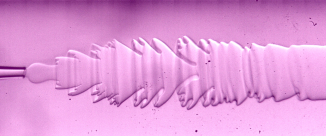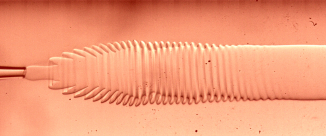Media
HKU Engineering undergraduates make use of a novel water-water system to explore the music of Beethoven to sounds in the inaudible world
22 Feb 2015
(from left) Student Jimmy Chan, Dr Anderson Shum and student Ms Sibyl Mak in front of the novel water-water system
A group of Mechanical Engineering undergraduate students at the University of Hong Kong, under the guidance of the department's Assistant Professor Dr Anderson Shum, has successfully “captured” Beethoven’s 5th symphony with a novel water-water system. The novel liquid system consists of a mixture of two immiscible aqueous phases, the interface of which possesses an ultra-low interfacial tension which is super-sensitive to stimulation of sound waves, i.e. any sound, audible or inaudible, can be “visualized” along the water-water interface.
In this research, the musical notes of Beethoven’s 5th symphony manifested themselves when passing through the aqueous interface of the system. And when translated back to music, the accuracy was over 97%, which is illustrative of the high sensitivity of the interface in detecting sound waves.
This “discovery” was reported in renowned academic journal Nature Scientific Reports, under the Nature Publishing Group. The achievement highlights the high quality of undergraduate research at HKU.
Besides audible sound, the system is capable of detecting sound waves with frequency lower than 20 Hertz, i.e., inaudible to human beings. It is anticipated that making use of this novel water-water system, sounds that are currently unknown to us can be heard. This would not only allow monitoring of infra-sounds generated by windmills or large electronic appliances such as air-conditioners, but also provides an opportunity to understand the communication among huge animals, such as elephants and whales, that communicates through inaudibly pitches with frequencies that can be below 10 Hertz.
Moreover, small fluctuations exist in human body; examples are heart beat and breathing cycle. In Chinese medicine, patterns of pulses signify the patient’s body conditions. Our approach provides a potential solution for capturing and precise measurements of these pulses and messages emitted by body organs or tissues transmitted through the bloodstream or body fluid. It will facilitate the development of relevant health technologies such as human body acoustics, or diagnosis of diseases.
The students involved in the projects are currently either pursuing higher degrees in engineering or working in the industry.
For media enquiries please contact Ms Jolly Li, Faculty of Engineering, HKU (Tel: 2241 5953 / E-mail: [email protected]).
Musical notes of Beethoven's 5th symphony manifest themselves when passing through the aqueous interface


